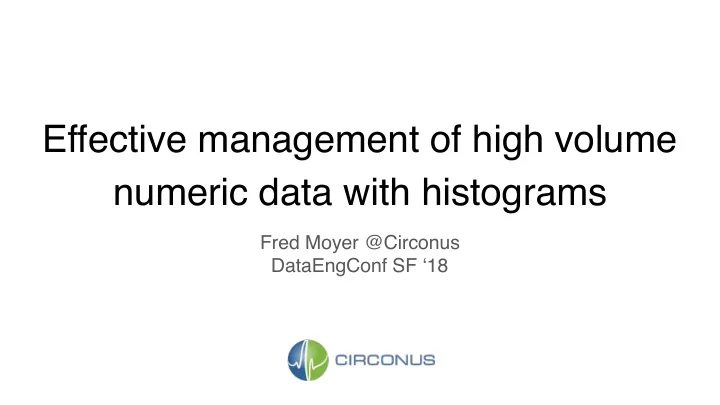

Effective management of high volume numeric data with histograms Fred Moyer @Circonus DataEngConf SF ‘18
@phredmoyer ● Engineer to Engineer @circonus ● Recovering C and Perl programmer ● Geeking out on histograms since 2015
Pain driven development ● Observability tools caused a telemetry firehose ● Existing monitoring systems got washed away ● Average based metrics gave limited insight
“Effective Management” ● Performance AND scalability ● Avoid memory allocations, copies, locks, waits ● Persist data in size efficient structures
Histogram Basics Mode q(0.9) Median q(0.5) Number of q(1) Mean Samples Sample Value
Heatmap Basics
Histogram Types ● Fixed Bucket ● Approximate ● Linear ● Log Linear ● Cumulative
Fixed Bucket User specified bins/ buckets Number of Samples Sample Value
Approximate Centroids indicating data grouping Number of Samples Sample Value
Linear Evenly sized bins Number of Samples Sample Value
Log Linear Logarithmically increasing bin sizes Number of Samples Sample Value
Cumulative Number of Total Sample Samples Count Sample Value
Custom Number of Samples Sample Value
Open Source Log Linear C - github.com/circonus-labs/libcircllhist Go - github.com/circonus-labs/circonusllhist
Open Source Log Linear
Open Source Log Linear Bin size increase by 10x 90 bins
Open Source Log Linear
Bin data structure Value Exponent Count int8_t int8_t uint64_t 1 byte 1 byte Max 8 bytes Varbit encoded
Storage efficiency - 1 month 30 days of one minute histograms 30 days * 24 hours/day * 60 bins/hour * 300 bin span * 10 bytes/bin * 1kB/1,024bytes * 1MB/ 1024kB = 123.6 MB
Storage efficiency - 1 year 365 days of five minute histograms 365 days * 24 hours/day * 12 bins/hour * 300 bin span * 10 bytes/bin * 1kB/1,024bytes * 1MB/ 1024kB = 300.9 MB
Quantile calculation 1. Given a quantile q(X) where 0 < X < 1 2. Sum up the counts of all the bins, C 3. Multiply X * C to get count Q 4. Walk bins, sum bin boundary counts until > Q 5. Interpolate quantile value q(X) from bin
Linear interpolation right_count=800 bin_count=200 left_count=600 Q = 700 q(X) = left_value+(Q-left_count) / X = 0.5 (right_count-left_count)*bin_width q(X ) = 1.05 q(X) = 1.0+(700-600) / (800-600)*0.1 left_value=1.0 right_value=1.1
Recap ● Several different types of histograms ● Highly space efficient ● O(1) and O(n) complexity calculating quantiles ● What other fun things can we do?
Inverse Quantiles ● What’s the 95th percentile latency? ○ q(0.95) = 10ms ● What percent of requests exceeded 10ms? ○ 5% for this data set; what about others?
Inverse Quantile calculation 1. Given a sample value X, locate its bin 2. Using the previous linear interpolation equation, solve for Q given X
Inverse Quantile calculation X = left_value+(Q-left_count) / (right_count-left_count)*bin_width X -left_value = (Q-left_count) / (right_count-left_count)*bin_width (X-left_value) /bin_width = (Q-left_count)/(right_count-left_count) (X-left_value)/bin_width *(right_count-left_count) = Q-left_count Q = (X-left_value)/bin_width*(right_count-left_count) +left_count
Linear interpolation left_count=600 right_count=800 Q =(X-left_value)/bin_width * (right_count-left_count)+left_count Q = (1.05-1.0)/0.1*(800-600)+600 X = 1.05 Q = 700 left_value=1.0 right_value=1.1
Inverse Quantile calculation 1. Given a sample value X , locate its bin 2. Using the previous linear interpolation equation, solve for Q given X 3. Sum the bin counts up to Q as Q left 4. Inverse quantile q inv (X) = (Q total -Q left )/Q total 5. For Q left =700 , Q total = 1,000 , q inv (X) = 0.3 6. 30% of sample values exceeded X
Quantiles - Heatmap
Quantiles - q(0.9)
Inverse Quantiles - SLO
Inverse Quantiles - SLO
Inverse Quantiles - SLO
Anomalies
Thank you! Questions? Bug me at the Circonus booth Come to Office Hours Tweet @phredmoyer or @circonus
Recommend
More recommend